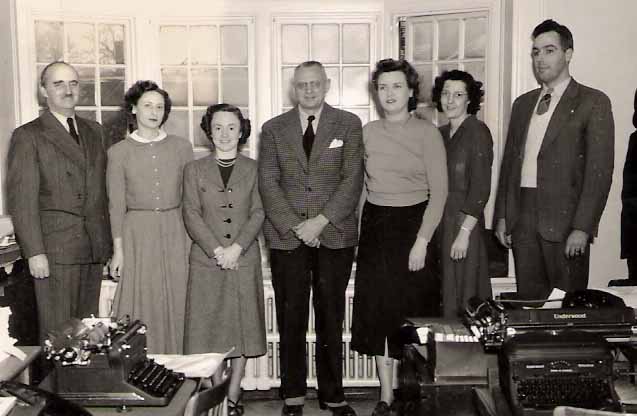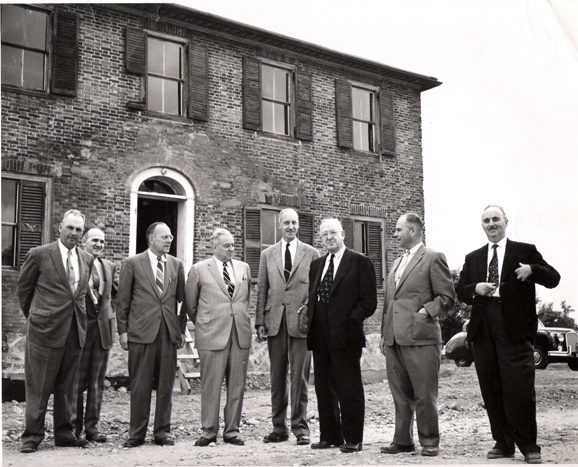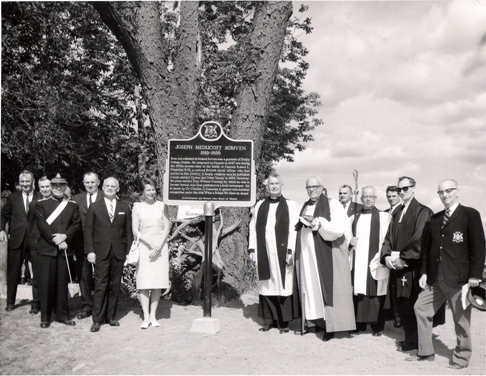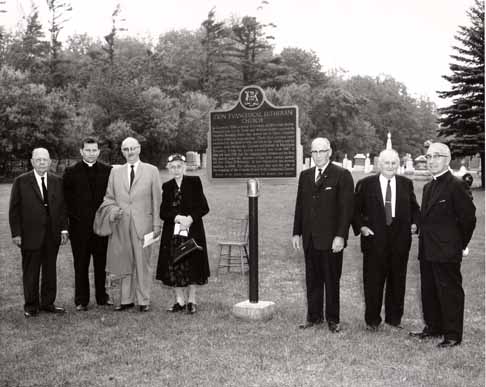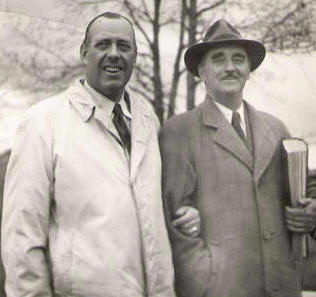
Ganaraska Forest
-
Conservation History -
homepage
Ganaraska History
V.B. Blake
Pioneer Historian
E. J.
Zavitz
Chief of Reforestation
A.H.
Richardson
Forester
Dr. R.C.
Wallace
"Wallace of Queen's"
G.M. Wrong
History Prof./Author
Lois James
Champion
of the Rouge
links
email
"Every man is an omnibus in which his ancestors ride."
Oliver Wendell Holmes
A man doesn’t plant
a tree for himself. Alexander Smith,
He plants it for posterity.
Scottish Poet (1830-1867)
The unrecorded past is
none other than our old friend,
Barbara Tuchman
the tree in the primeval forest
which fell without
being heard.
"It has been said that we
are passing through the present
into the future so quickly
Dr. G. Ross Lord as quoted in
that we tend to forget the past… The work of conservation will never
end. Perhaps
most
conservationists are men of whom the prophet Joel wrote ‘Your old men
shall dream dreams, your young men shall see visions."
Conservation by the People (1974)
"Society should not seek
to destroy the past, but to
First heritage statute
improve upon it."
passed in Rome 457A.D (Majorian)
For the real history of man on this
earth
is not the record
Hamilton Wright Mabie
of the deeds he has performed
with his hands,
the journeys he has made
with his feet,
the material things he has fashioned with his mind,
but the record of his thoughts, feelings, inspirations,
aspirations,
and experience.
It is the story of his spirit which is
significant…
Essays on Nature and Culture, 1896
“The eye sees only what the mind is prepared to comprehend."
Henri Bergson, French philosopher
A lake
is the landscape's most The Ponds,
Walden,
beautiful and expressive feature.
It is Earth's
eye; looking into which the beholder measures
the depth of his own nature.
Henry David Thoreau
Henry David Thoreau
What I Lived For, pg. 101
The Legend of V.B. Blake
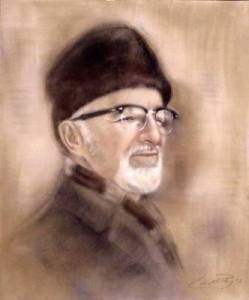 |
Verschoyle Benson BLAKE
(1899-1971)
"We
need something more than archives
to tell us how our forefathers lived...
to read this in books and pictures is a good thing, but it is
infinitely better to preserve some of the things themselves.
To let these be lost through our indifference is to deprive
future generations of a heritage to which they are entitled."
V.B. Blake as quoted in
Conservation by the People:The History of the Conservation Movement in Ontario to 1970,
by A.H. Richardson (1974) p. 103
Verschoyle Benson Blake (1899-1971) was a highly respected historian and an early pioneer in the conservation movement.
A strong intellectual, V.B. Blake (“Vers” to friends) was extraordinarily knowledgeable and extremely well spoken. His illustrious pedigree can be traced back to one of the Knights of the Roundtable.
The above portrait of V.B. Blake was commissioned by the Ministry of Citizenship, Culture (MCC) after his passing in 1971. The portrait hung at its Bloor St., Toronto office for decades in remembrance of one of the most distinguished local historians of the time.
|
Excerpt from Press
Release of Port Hope
(East Durham) Historical Society "Story of pioneering conservationist to be told... We tend to take the Ganaraska Forest and the millions of evergreens on the Great Pine Ridge for granted. There are still many in the old United Counties, however, who remember when the area north of Port Hope was a dust bowl of eroding hills and abandoned farms. The massive reforestation undertaken in the late Forties and early Fifties transformed our landscape. One of the visionary pioneers who worked behind the scenes was a shy, self-effacing historian and conservationist named Verschoyle Benson Blake. Blake bought a farm northwest of Garden Hill in 1926, and began tree-planting experiments. When Dr. A. H. Richardson laid the groundwork for the Forest, he hired Vers Blake as lead historian for the report that provided the impetus for the project. Blake’s contribution to conservation and the preservation of Ontario’s history remains an untold story... Ron Getz, President"
Public Meeting held at the
Ganaraska Region Conservation Authority |
Blake's historical research can be found published in numerous conservation reports throughout the Province of Ontario. His interest also included Canada's built heritage. V.B. Blake was a founding member of the Architectural Conservancy of Ontario (1933).
Blake's life can be summed up:
“To this day Verschoyle Blake is considered by his peers
as the dean of all local historians."Carl Thorpe, Retired Manager, Ministry of
Culture Heritage and Libraries Branch (2003)
BLAKE'S ARRIVAL IN THE GANARASKA AREA
It was poor unproductive farmland on the Oak Ridges Moraine when Blake arrived in 1926 for by then, the cumulative effects of early settlement and the lumber industry had left a devastated landscape devoid of natural vegetation. Blowouts from sand dunes were frequent.
On land once described as the “sandy desert of the north”, Blake began treeplanting experiments at the place he named "Ardfree" which became a practical demonstration of the merits of good conservation practices. Blake's ongoing tree planting experiments (plantations) quietly waited for the big one to come - unknowingly, Blake had planted the first seeds.
The “conservation in miniature” project of Blake was two decades
before the establishment of Ganaraska Forest to the east, west and north. By then, Blake had acquired extensive knowledge of the Ganaraska area and of treeplanting. He was also the only area resident on the original Ganaraska survey team.Blake's strong connections, his ongoing tree planting experiments (plantations) and his conservation in miniature project as a demonstration model, probably helped influence the choice of Ganaraska as the first test area in the province.
PROMINENT FAMILY PEDIGREE
Verschoyle Benson Blake (VBB) was born in Toronto on May 26, 1899 and came from one of Ontario’s oldest and most prominent families. VBB was the last male in his branch of the prominent family tree - his ancestry can be traced back to one of the knights of King Arthur's Round Table (Ap-Lake).
VBB was descended from a lineage of strong intellectuals - the Blakes of Galway (in Ireland). The Blake Family were devoutly evangelical Anglicans and one of the most powerful families in the area. They were also very active in city government.
The illustrious pedigree of Verschoyle B. Blake also shows he was related to several distinguished and prominent intellectuals including:
- Grandson of THE RIGHT HON. EDWARD BLAKE (1833-1912) - first leader of the federal Liberal Party (1879-1887), the first Liberal Party Premier of Ontario after Confederation and Chancellor of the University of Toronto (1876 to 1900). He was responsible for establishing the Liberal dynasty that ruled in Ontario from 1871 to 1905. Edward Blake was also a Federal Cabinet Minister and a Constitutional Lawyer instrumental in the establishment of the Supreme Court of Canada.

The Rt. Hon. Edward Blake
Edward Blake was not only a distinguished lawyer but a brilliant orator whose speeches which sometimes lasted six hours. Blake was the co-founder of Blake, Cassels & Graydon, or Blakes for short - one of Canada’s largest law firms. Also: National Historic Person of Canada.
In 1858, Edward Blake married Margaret Cronyn (1837- ), second daughter of the Right Reverend Benjamin Cronyn, Bishop of Huron. Their sons, Edward Hume, Edward Francis (Ned - VBB's Father) and Samuel Verschoyle, all entered the family law firm. Their daughter, Sophia Hume, married Professor George MacKinnon Wrong who was in charge of the History Dept. at the University of Toronto.
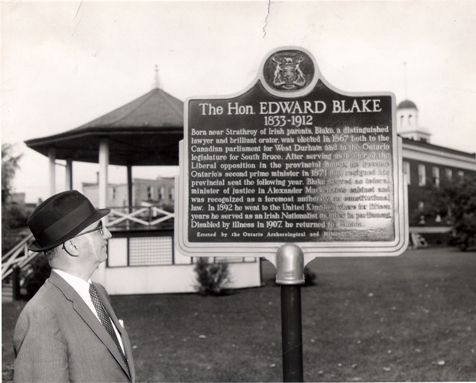
V.B. Blake next to the plaque of his
Grandfather, The
Rt. Hon.
Edward Blake
Photo courtesy of Elisabeth Bacque
-
WILLIAM HUME BLAKE (1809 - 1870) Solicitor-General for Canada West (1848) and the Chancellor of Upper Canada (1849). A leading lawyer of his time and a pioneer in legal education at King's College in Toronto where he initiated significant reforms in the Upper Canadian judicial system. Father of Edward Blake
-
REV. BENJAMIN CRONYN (1802-1871) elected first Bishop for the Diocese of Huron (Anglican Church of Canada) - area comprised of 12,000 square miles in southwestern Ontario
-
THOMAS BENSON (1804-1857) First Mayor of Peterborough. In 1853 - settled in Port Hope
-
Judge THOMAS M. BENSON (1833 – 1915) - A portrait of Judge Benson hangs in Victoria Hall in Cobourg
|
|
Blake Coat of Arms - Galway County Ireland
("Virtue alone enobles")
-
GEORGE M. WRONG
- prominent Canadian historian and first history professor
at the University of Toronto - Prolific Author of numerous books on
Canadian history. Professor Wrong also played a key role in the development of the historical
profession in English-speaking Canada. Recognized as a National Historic
Person of Canada.
G. M. Wrong was V.B. Blake's favorite uncle and mentor
-
Blake was a frequent guest of George Wrong at Durham House
in nearby Canton.
In the summer of 1929 George Wrong offered to sell the rights to the mill and dam to his former pupil, Vincent Massey, but no agreement was reached until the early 1930s, when George was suffering financially from the stock market crash. A deal was reached and Vincent Massey erected his residence named Batterwood.
Also see: George M. Wrong
-
AP-LAKE, one of the knights of King Arthur's Round Table. The Blake pedigree is recorded in the Office of Arms, Dublin Castle in great detail. Historically, the original Welsh spelling of Blake was Aplake, meaning "the son of the lake”. Through the centuries, the spelling of A'Plake changed to Blaake, and then Blake. Describing the Blake family’s origin, in 1820:
“This family is of British extraction, and, though the name seems derived from the Saxon, Blac, a colour; yet, Debrett, in his Baronetage, says, "they are traditionally descended from Ap-lake, one of the knights of King Arthur's round table,'' and adds, ''that in the reign of Henry II, one of this family accompanied Strongbow, and after many exploits built himself a castle, at Menlo, near Galway.'' --- Richard Caddell surnamed Blake, (from whom, according to Lynch's MS. the Blakes of Galway are descended,) was sheriff of Connaught, Vicecomes Conacioe, 32 and 33 Edw. I, he was also sheriff in 1306. and in 7 Edw. Il. the king's writ issued, for arrearages of his account. --- Rot. Mem. --- The arms of this family were first borne by him and descended to his posterity. The family of Ardfry, descended from Sir Richard Blake, who was speaker or chairman, of the assembly of the confederate catholics of Ireland, at Kilkenny, in 1647, was raised to the dignity of the peerage, in the year 1800, in the person of Joseph Henry Blake, Esq.” James Hardiman (1820)
Continuing their strong involvement in government affairs, the Blake family came to Upper Canada from Ireland in the early nineteenth century, where William Blake (1809-1870) and his son Edward (1833-1912) became distinguished in law and the administrative affairs of Canada.
The name Verschoyle has old Celtic roots tracing back to Ireland. Other relatives of VBB include: Samuel Verschoyle Blake (youngest son of Edward Blake); Harold Verschoyle Wrong (son of Professor George M. Wrong) and Verschoyle Cronyn (the son of Rev. Benjamin Cronyn).
The Blake Family was linked by marriage with the Cronyn, Wrong and Benson families.
Public Service
From 1945 to 1962, V. B. Blake worked as historian for the Conservation Branch of the Ontario Department of Planning and Development. He was also responsible for researching the history of land ownership and land use in areas protected under the Conservation Authorities Act.
Blake became Supervisor of the Historical section of the Conservation Authorities Branch when it began publishing historical studies for various geographically defined conservation areas across Ontario - beginning with the Ganaraska Watershed report (1944).
"Historian Verschoyle B. Blake was added to the survey team. It was Blake’s keen sense of the worth of history and his philosophy of how the conservation ethic could be supported through an understanding of the past that resulted in the inclusion of an introductory historical chapter in the Ganaraska study. Subsequent conservation reports by the government would also include accounts of the historical background of each watershed area studied, since Blake and Richardson believed that the public would find this material interesting and then be better able to understand the technical recommendations."
(John C. Carter, Ontario Conservation Authorities:
Their Heritage Resources and Museums, Ontario History
Volume XCIV, No. 1, Spring 2002)
Inclusion of the historical introduction in the conservation reports was considered controversial at the time because history was considered to have little to do with conservation.
A pivotal meeting occurred in Toronto - public acceptance and the success of the Ganaraska Forest project was at stake. Dr. R.C. Wallace, esteemed educator, wrote the Introduction of the The Ganaraska Watershed report (1944) and ensured the study and subsequent studies in other areas were "grounded in history". This meeting was also a turning point for V.B. Blake who was the key historian on the Ganaraska project.
|
The Ganaraska Report (1943): "The Ganaraska Report opened with a chapter on the history of the area. It presence was controversial because history was considered by many technical men to have little if anything to do with conservation. This report established that human heritage would be considered a resource from which lessons would be learned and applied, and that it would be included in the mandate of conservation authorities... Although the small Ganaraska watershed was ideally suited for the survey, it was equally rich in historical interest extending back 150 years. The settlement at the mouth of the Ganaraska River, known first as Smith's Creek, for a short time as Toronto, and later as Port Hope, had its beginning in the 1790s, at the same time as Lieutenant-Governor Simcoe was establishing the Town of York, now Toronto. When it was decided to print the Ganaraska report (The Ganaraska Report (1943), a meeting was called in Toronto of those responsible for the promotion of the survey to decide the general format and to discuss abridgements or additions. Dr. R.C. Wallace, principal and vice-chancellor of Queen's University was in the chair. After some discussion on the historical section as to its length, contents, and whether or not it was germane to the survey, Dr. Wallace asked for a show of hands. A few were in favour of reducing it considerably but the majority voted that the whole section should be deleted; they considered history had little relation to the technical aspects of conservation. Then, as chairman, Dr. Wallace took the floor and with diplomacy and tact, said he did not agree; on the contrary, he said, he considered the section on history the most interesting in the report. It would, he said, go far to making the report more acceptable to a wide circle of readers. He then ruled that the section should be left in and any abridgement be left to Dr. Marsh and me. With this excellent support from an eminent educator, it was evident that here was an open sesame to promote and encourage historical projects in the programmes of the authorities, if they should be formed..." Greening Our
Watersheds - Revitalization Strategies 2002 Ch. 5 p.75 |
History was seen as the "the sugar coated pill, which it was hoped, would stimulate the interest of the reader and entice him to read the report in full."
(A.H. Richardson, Conservation by the People: The History of the Conservation Movement in Ontario to 1970, (1974), p. 103)Blake had extensive local knowledge and helped compile the Ganaraska Watershed report published in 1944. According to A.H. Richardson, (1974): "The work in compiling the report… was done during the fall of 1942 and the spring of 1943. In this work, Verschoyle B. Blake… of great assistance..."
Historical section staff of the Conservation Authorities Branch - V.B. Blake (far left)
Photo courtesy of Elisabeth Bacque
The Ganaraska Watershed (1944) report which Blake helped to compile, represented a completely new way of looking at conservation in Ontario and Canada. It was the impetus which led to the passing of the Conservation Authorities Act and the creation of the first conservation authorities in Ontario.
The success of the Ganaraska study also led to the establishment of Ganaraska Forest, the largest forest in southern Ontario and to the formation of the conservation authorities in Ontario whose collective efforts in watersheds across the province would provide a foundation for the creation of the largest greenbelt in the world (Ontario's Greenbelt, 2005).
As previously noted, Blake became Supervisor of the Historical section of the Conservation Authorities Branch when it began publishing historical studies for various geographically defined conservation areas (watersheds) in Ontario.
Following the Ganaraska Watershed Report, Blake's work can also be found in many other conservation reports in Southern Ontario including:
Etobicoke Valley Report (1947)
Napanee Valley Conservation Report (1957)
Humber Valley Report (1948)
Ausable Valley Report (1949)
Don Valley Conservation Report (1950)
Moira Valley Conservation Report (1950)
Upper Thames Valley Conservation Report (1952)
Saugeen Valley Conservation Report (1952)
Upper Holland Valley Conservation Report (1953)
Upper Saugeen Valley Conservation Report (1953)
Credit Valley Conservation Report (1956)
R(ouge River,) D(uffin,) H(ighland), and...
P(etticoat Creek) Valley Conservation Report (1956)
Otter Valley Conservation Report. (1957)
Otter Creek Conservation Report (1962)
Big Creek Region Conservation Report (1963)
Otonabee Region Conservation Report (1964)
Spencer Creek Conservation Report (1959-)
During the 1950's, V.B. Blake also helped organize the Provincial Plaques Program in Ontario.
Blake was also on the Advisory Committees for both Upper Canada Village and Black Creek Pioneer Village. He was instrumental in establishing Barnum House in Grafton as a museum.
Upper Canada Village, Cook's Tavern, August 12, 1957 (V. B. Blake far right)
Photo courtesy of Elisabeth Bacque
In 1956, the Archaeological and Historic Sites Board of Ontario began erecting plaques across the province to stimulate public awareness of, and pride in Ontario's past.
Blake was present at many plaque dedications.
Plaque dedication to Joseph M. Scriven (1819-1886) - VBB (far right)
Photo courtesy of Elisabeth Bacque
Plaque dedication (above) to Zion Evangelical Lutheran Church
VBB third from left - Photo courtesy of Elisabeth Bacque
Prior to the St. Lawrence Seaway being opened in 1959 (and the river being widened), Blake worked on the relocation of the early cemeteries by the St. Lawrence River. He was also involved in the recording and measurement of the seaway buildings.
In 1962, Blake moved to the Historical Branch of the Ontario Department of Public Records and Archives where he remained until his death in 1971.
His colleagues including Carl Thorpe recalled in a recent telephone interview "There hasn't been anybody like him since." He and others also expressed:
“To this day, Verschoyle Blake is considered by his peers
as the dean of all local historians."Carl Thorpe, retired Manager of Heritage and Libraries Branch,
Ministry of Culture, telephone interview - December, 2003
"Vers was one of my favourite people - he got me my first job at Upper Canada Village. He was extraordinarily knowledgeable and
well-connected - a most rewarding person to talk to."Peter Stokes, Architectural Historian 2007

“I worked with Vers Blake in my early days at the Ontario Archives. An amazing, kind, gentle, and gentleman-ly man, if there ever was one."
Bernadine Dodge, retired Head Archivist, Trent University, 2005
I first met Vers in 1959, when I joined the staff of the Historical Branch of the Provincial Government, whose function it was to prepare some forty historical plaques each summer for erection around the province. We did the research during fall, winter ("...and still the wonder grew that one small head could carry all he knew"...).“... more a beloved older brother than a friend as the years went by...
Ken McPherson, Retired Archivist
(email dated August 3, 2008)
Verschoyle Blake exemplified human greatness although he did not seek it. He never sought acclaim or recognition for himself. Blake's work remains a goldmine of information for historians even today.
However, Blake's
work was usually overshadowed by A.H. Richardson. According to Dr. Dr. John C. Carter:“
I see Blake much as I see John George Hodgins. Both were tireless advocates for their causes but tended to be overshadowed by their bosses. Verschoyle Blake by A.H. Richardson and Hodgins by Ryerson. Both Blake and Hodgins should be recognized for what they did and accomplished during their long lives as Ontario public servants…” (Dr. John C. Carter - Museum Advisor - Ministry of Citizenship Culture in email dated November 30, 2005).
A tribute to vanishing rural Ontario, a book entitled "Rural Ontario" was published in 1969 by Verschoyle Benson Blake (text) and Ralph Greenhill (photographs) about rural architecture in Ontario in the nineteenth century.
Blake remained with the Ontario Government until his passing.
V.B. Blake passed away on April 6, 1971 - the end of the male line of a very prominent family lineage. He never married.
Blake quietly rests in Port Hope beside his maternal
ancestors (the Bensons), including Thomas Benson, the first Mayor of Peterborough and Judge Thomas Moore Benson.Prosopography
|
Prosopography - a study that identifies and draws relationships between various characters or people within a specific historical, social, or literary context. It also includes an investigation of the common characteristics of a historical group - an independent science of social history embracing genealogy, onomastics and demography. Prosopography permits the political history of men and ‘events’ to be combined with the hidden social history of long-term evolutionary processes. |
In September, 2008, Professor Paul Litt, Public Historian at the Ontario Heritage Foundation and a policy advisor for the Ontario Ministry of Culture was contacted and asked whether there might be some meaningful correlation between the four men (Blake - Wrong - Massey - McKenzie King), i.e.
- V.B. Blake was the grandson of Edward Blake – founder of the
Liberal dynasty and a Person of National Historic
Significance of Canada;
- V.B. Blake was related to George M. Wrong who married Edward Blake’s daughter, Sophia (Prof. Wrong also a Person of National Historic Significance of Canada);
-
Wrong and V.B. Blake were both well known
historians and with country estates
north of Port Hope (named Durham House and Ardfree respectively);
G. M. Wrong was V.B. Blake's favorite uncle and mentor
-
Blake was a frequent guest at Durham House in nearby Canton.
- Gov. Gen. Vincent Massey (Canada's first Canadian born Governor General - also a Person of National Historic Significance of Canada) was a former student of Prof. Wrong at the University of Toronto and a Liberal. Massey later purchased part of Prof. Wrong's property in Canton. Massey and Wrong became neighbors. Massey was well acquainted with Mackenzie King and C.D. Howe, also Liberals;
- In 1933, V.B. Blake and C. Vincent Massey were two of the founding members of the Architectural Conservancy of Ontario
“ What you are saying about the possible connections between Blake and Massey et. al. is very interesting. My instinct is that it all makes sense that he was part of such a crowd—the pedigree, the cultural interests, etc. all match. It reminds me of that wonderful word “prosopography” which suggests that researchers should pay attention to who their subject hung around with because the cultural prejudices of peer groups are the intellectual micro-climates in which they live day to day. The Masseys and the Wrongs were related through marriage… King certainly knew Massey… "Paul Litt, History Professor
at Carleton University
OTHER INFLUENCES
-
John C. Boylen
Capt. John C. Boylen was a highly regarded friend of Blake. He was in the 127th Battalion, Queen's York Rangers during the World War I.
Boylen was past secretary of the Ontario Historical Society, President of the York Pioneers and Historical Society and former Mayor. He was also the author of "York Township: a Historical Summary", 1954 and "Castle Frank", 1956.
John Chancellor Boylen (L) and V.B. Blake (R)
Photo courtesy of Elisabeth Bacque
Bagnani Connection
Two respected friends of V.B. Blake were Professors Gilbert Bagnani and Stewart Bagnani (1903-1996), Professors of Ancient History at Trent University until 1975. (Prof. Gilbert Bagnani was also well known at the University of Toronto, before he moved to Trent toward the end of his career).
The Bagnanis and Blake shared common interests and they had country homes near Port Hope named Vogrie and Ardfree respectively.
Blake helped the Bagnanis renovate the interior of their home Vogrie. Blake also designed the library which was added to Vogrie in the 1930's.
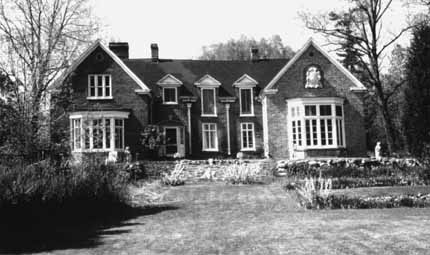
Vogrie near Port Hope, Ontario
A letter from Stewart Bagnani to her husband Gilbert, the name "Ardfree" is shown as the address of the sender (name of Blake's residence north of Port Hope). It was evident Stewart stayed at Ardfree while Vogrie was being renovated. (Bagnani fonds, Trent University Archives 97-003)
Professor Gilbert Bagnani presented his friend Verschoyle Blake with a very special book which was later donated after Blake’s passing to the Thomas Fisher Rare Book Library, University of Toronto:
“A work with an interesting background came to us from Elizabeth Bacque who presented us with Claudio Tolomeo's Geografia (Venice, 1598) Not only is this a very nice addition to our early imprints, but it has the added feature of having been presented to her uncle, Verschoyle Blake, by Gilbert Bagnani. These two scholars lived near each other in the countryside north of Port Hope and shared common interests. Blake designed the renovations to Vogrie, the Bagnani's home, including the large living room which contained their book and art collections. As the Fisher Library, several years ago, was the grateful recipient of many of Professor Bagnani's books, we are especially pleased to be able to add this volume to our holdings." (Luba Frastacky, Thomas Fisher Rare Book Library, University of Toronto (The Halcyon, June 1999)
Researcher: M. Martin
c2014
